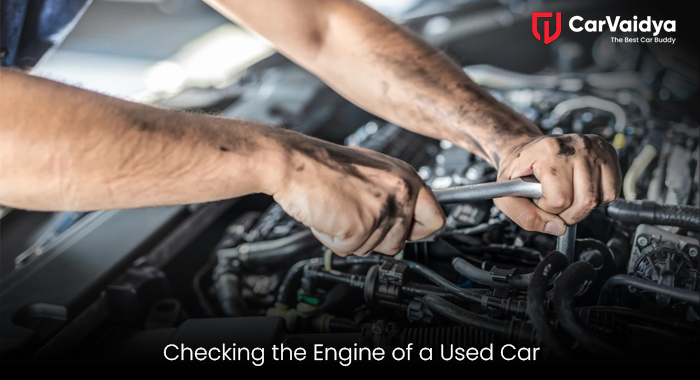Buying a used car can be a smart financial decision, but ensuring the engine is in good condition is critical. The engine is the heart of the vehicle, and its performance determines the car’s reliability and longevity.
1. Visual Inspection
Start with a thorough visual inspection of the engine bay. Look for the following
- Leaks: Check for oil, coolant, or other fluid leaks around the engine block and under the car. Leaks indicate potential issues that might require costly repairs.
- Corrosion and Rust: Examine the engine components for signs of corrosion or rust. These can indicate neglect or prolonged exposure to harsh conditions.
- Belts and Hoses: Inspect belts and hoses for cracks, wear, or brittleness. These are vital for the engine’s operation and can be expensive to replace.
- Cleanliness: A clean engine bay often reflects good maintenance, although overly clean engines may have been recently detailed to hide issues.
2. Check the Engine Oil
Engine oil is a critical lubricant, and its condition can tell a lot about the engine’s health
- Color: Pull out the dipstick and inspect the oil. Fresh oil is amber-colored, while older oil can be dark brown or black. Milky or foamy oil may indicate a blown head gasket or coolant mixing with oil.
- Level: Ensure the oil level is within the recommended range on the dipstick.
- Consistency: Rub some oil between your fingers. Gritty particles could suggest internal engine wear.
3. Inspect Coolant Condition
Coolant prevents the engine from overheating. Check the coolant reservoir
- Color: Healthy coolant is usually green, orange, or pink, depending on the type. Discoloration or sludge may indicate contamination.
- Level: Ensure the coolant level is between the minimum and maximum marks.
- Leaks: Inspect the radiator, hoses, and water pump for any signs of leaks.
4. Examine Exhaust Smoke
Start the engine and observe the exhaust smoke
- Blue Smoke: Indicates burning oil, which could mean worn piston rings or valve seals.
- White Smoke: Suggests coolant entering the combustion chamber, potentially due to a blown head gasket.
- Black Smoke: Indicates excessive fuel consumption, possibly due to a faulty fuel injector or air filter.
The exhaust should ideally produce no visible smoke once the engine is warm.
5. Listen to the Engine
The sounds an engine makes can reveal a lot about its condition. When the engine is running
- Idle Noise: Listen for a smooth, steady hum. Any knocking, ticking, or tapping sounds could indicate issues like worn bearings or valve problems.
- Rev Noise: Gradually rev the engine and listen for irregularities. Squealing may indicate a worn belt while knocking could mean more serious internal damage.
- Startup Noise: Pay attention to how the engine sounds on startup. Difficulty starting or unusual noises may indicate battery or ignition system problems.
6. Check the Performance
Take the car for a test drive to evaluate the engine’s performance under various conditions
- Acceleration: The car should accelerate smoothly without hesitation.
- Power: Ensure the engine delivers consistent power without surges or lags.
- Idle: Observe the engine’s behavior when idle. It should remain steady without fluctuating RPMs.
- Temperature: Monitor the temperature gauge. Overheating during the drive could signal cooling system problems.
7. Scan for Error Codes
Modern cars have onboard diagnostic (OBD) systems that can provide valuable insights. Use an OBD-II scanner to check for stored error codes
- Active Codes: These indicate current issues with the engine or other systems.
- Pending Codes: These suggest potential problems that may arise soon.
- Cleared Codes: Ensure codes haven’t been recently erased to hide problems.
8. Review Maintenance Records
Ask the seller for the car’s maintenance history. Regular oil changes, timing belt replacements, and tune-ups indicate proper care. Lack of documentation can be a red flag.
9. Get a Professional Inspection
If you’re uncertain about assessing the engine, hire a qualified mechanic for a pre-purchase inspection. They can identify hidden issues and provide a comprehensive report.
10. Look for Warning Signs
Be cautious of the following red flags
- Check Engine Light: A lit warning light could indicate engine problems.
- Unusual Smells: Burning oil, coolant, or fuel odors are warning signs.
- Excessive Vibrations: Rough idling or excessive engine vibrations may suggest underlying issues.
11. Verify Mileage and Age
Higher mileage engines typically experience more wear and tear. Compare the car’s mileage with its maintenance history to determine if it’s been well cared for.
Checking the engine condition of a used car requires attention to detail and a methodical approach. Following the steps outlined above, you can minimize the risk of buying a vehicle with hidden engine problems. Always remember that investing time and effort in a thorough inspection can save you from costly repairs and ensure a better ownership experience.
You can read some other articles
5 Easy Ways to Fix Scratches on Your Car's Touch Screen
DIY Guide: Changing Your Car's Air Filter
Car Mileage: Understanding and Optimizing Fuel Efficiency


0 Comments